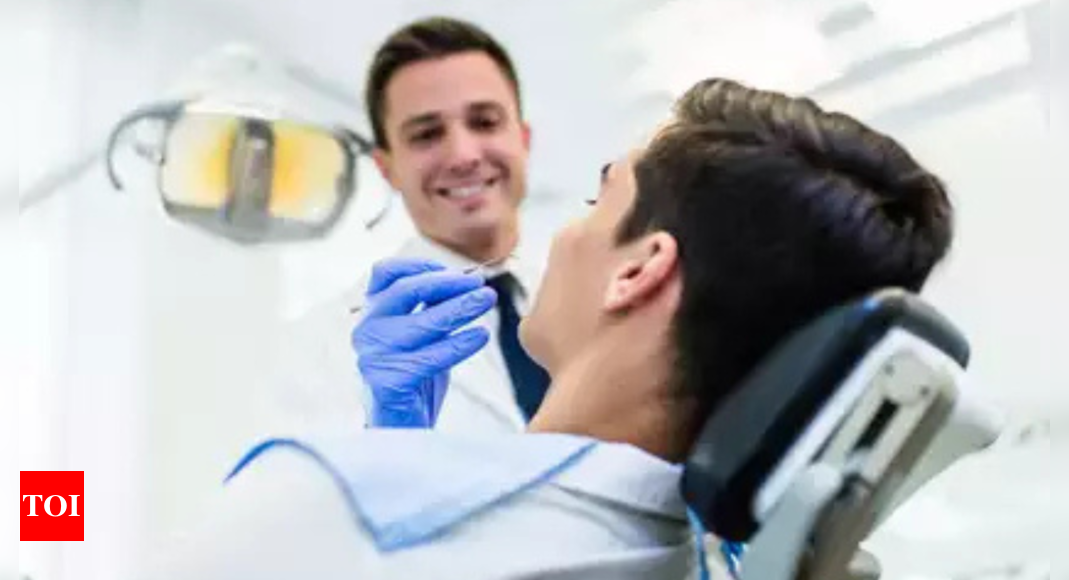
NEW DELHI: In modern dentistry, fears over post-procedure looks have gently faded, whether the path is surgical, non-surgical, or simply cosmetic.
Today, advanced artificial intelligence steps in with a painter’s precision, analysing each unique aesthetic detail — the lines and curves of the face, the harmony of proportions, the depth of shade.
With this, a vision of the final smile is brought to life through digital rendering, a glimpse of beauty to come, crafted with art and science entwined.
According to experts, the field of dental care has experienced significant transformation through technological innovation. These advancements have made substantial contributions to elevating dental healthcare standards.

Dr Ashish Kakkar, senior consultant, dental surgery, Indraprastha Apollo Hospitals, said computer-guided implant surgery ensures optimal implant positioning, while piezosurgery enables precise bone cutting with minimal trauma, particularly beneficial for extractions and advanced surgical procedures.
Laser treatments offer reduced bleeding and discomfort compared to conventional methods, particularly in soft tissue procedures and cavity removal.
“The integration of intraoral scanning cameras and digital imaging like photogrammetry has revolutionised diagnostic capabilities by providing instantaneous visualisation of dental conditions, thereby facilitating thorough treatment strategies. These technological advancements have resulted in shorter recovery periods and reduced discomfort, making dental visits more efficient and less daunting for patients,” he said.
Dr Shankar Iyer, director of Smile USA and faculty at Rutgers School of Dental Medicine and Jacksonville University, said AI’s primary function is prediction.
The technology can be programmed to provide various design features. The pre-programmed algorithms consider facial proportions, arch dimensions and teeth measurements, incorporating these elements to plan and design smiles accordingly.
The system processes aesthetic parameters, including facial proportions and dimensions, as well as teeth length, to calculate and generate smile renderings.
The surgical applications include orthognathic procedures for jaw length modifications or post-cancer reconstructive surgery involving complete jaw replacement. AI enables the creation of 3D printed jaw models, allowing surgeons to prepare with precise computer-designed templates. These templates guide the measurement and harvesting of leg bone tissue for implant placement in reconstructed jaw bone with high predictability and shorten the operatory time considerably.
Virtual orthodontic tooth movement can be done along the same lines, and the planning helps render aligners that enable orthodontic procedures without brackets or braces.
During tooth extractions, a simple procedure involving platelet-rich fibrin (PRF) is often used. A preparation that promotes bone growth, PRF serves as a foundation and scaffold for tissue regeneration. Patients receiving this treatment post-extraction avoid dry socket complications and require fewer analgesics. It also significantly improves the pace of soft tissue healing, making it a valuable addition to dental extraction procedures.
Dr Garima Yadav, a consultant implantologist at Fortis Hospital, Vasant Kunj, said AI has been integrated across all dental specialities, including operative dentistry, periodontics, orthodontics, oral and maxillofacial surgery, and prosthodontics. “Its implementation has demonstrated significant improvements in minimising errors whilst enhancing the precision and accuracy of dental procedures,” she added.
Highlighting the use of software applications for various dental procedures, including veneers and laminate, full coverage crowns, orthodontic alignment and denture, Dr Aditi Nanda, associate professor, CDER AIIMS, said, “Digitisation helps in designing as well as manufacturing these prostheses by either additive (3D printing) or subtractive methods (milling). It also enables archiving of data, which helps in quicker repeat manufacturing in case of loss of prosthesis or medico-legal reasons.”
Dr Nanda said modern techniques like sedation, alongside traditional local anaesthesia, have made implant dentistry less intimidating. However, she added, regardless of the chosen procedure, patients must strictly adhere to pre- and post-operative care instructions. Success in treatment relies heavily on proper follow-up care. Dr Gurkeerat Singh, director, dentistry department, Indian Spinal Injuries Centre, said it is empirically proven now that dental implants are nearly pain-free and can be provided as a walk-in procedure.
Dr Sageer Aazaz, head of dentistry, Paras Health, Gurgaon, said advanced techniques differ from conservative methods in their precision, efficiency and patient comfort.
According to Dr Bhumika Madan, consultant, dentistry, Aakash Healthcare Super Speciality Hospital, digital X-rays, laser treatments and clear aligners like Invisalign are particularly popular among patients due to their convenience and aesthetic benefits.
Dr Minaal Verma, a dentist from the US, highlighted the significance of photogrammetry in achieving precise dental implant placement. “It allows us to record the exact position of implants, creating the best possible fit for each restoration. This is essential for patient comfort, stability and long-term success of the implant,” she said.



